Relying on one sales channel can work, until it doesn’t. If you’ve been selling on Amazon for any length of time, you’ve probably seen how quickly things can shift. New fees are introduced, a new policy is created, or a sudden change in the search algorithm can throw your whole business off balance.
That’s why more Amazon sellers are starting to diversify, and linking Shopify to Amazon is one of the easiest ways to do it. Shopify gives you more control over your brand, a direct connection to your customers, and a place to build something you truly own, without walking away from the momentum you’ve already built on Amazon.
In this guide, we’ll walk you through exactly how to connect your Amazon and Shopify accounts, what apps to use, and how to manage everything without doubling your workload. If you’re ready to expand your business, this is your step-by-step guide to linking Shopify to Amazon in 2025.
Why Link Shopify to Amazon in the First Place?

If you’re already selling on Amazon, adding Shopify to the mix can feel like a big leap. But connecting the two platforms is pretty straightforward, and the benefits far outweigh the work. By linking Shopify to Amazon, you can expand your business while keeping everything synced in one place.
Instead of managing inventory, listings, and orders on two separate platforms, this integration allows you to centralize your workflow. Apps like Shopify Marketplace Connect (formerly Codisto) help you link listings, track stock in real time, and manage orders, all from inside your Shopify dashboard.
It’s also a smart way to get more mileage out of the infrastructure you’re already using. If you fulfill Amazon orders through FBA and want Amazon to also handle your Shopify orders, you can do that using Amazon’s Multichannel Fulfillment (MCF) program. MCF works behind the scenes to fulfill orders from Shopify using your existing FBA inventory, without the order needing to come through Amazon. It’s a separate service, but it runs on the same logistics network, so you can streamline fulfillment without managing multiple warehouses.
It’s not just about selling more, it’s about selling smarter. With the right setup, linking Shopify to Amazon lets you stay lean, stay organized, and stay focused on the things that actually help grow your business.
What You’ll Need Before Connecting Shopify to Amazon
Before linking Shopify to Amazon, there are only a few core things you’ll need to get started. Once those are in place, the actual connection process is fairly simple, especially if you’re using a tool like Shopify Marketplace Connect.
Here’s what you’ll need:
- A Shopify store: Your store should be active and have at least one product listed. While your listings don’t need to be perfect out of the gate, having product titles, images, and basic inventory info will help streamline the connection.
- An Amazon Seller Account: Shopify only integrates with Amazon’s Professional selling plan. If you’re still on an Individual plan, you’ll need to upgrade before you can link your accounts.
- An App to Link Both Accounts: This is the bridge between the two platforms. We recommend Shopify Marketplace Connect (formerly Codisto) since it is directly supported by Shopify and is very easy to use. However, there are other choices like CedCommerce, Amazon Importer Spreadr App, and Multichannel Importer
- Matching SKUs (Optional): While it’s not required, having matching SKUs for any product that exists on both platforms helps the app match and sync each product automatically.
Once you’ve got these basics covered, you’ll be ready to connect and start selling across both platforms.
How to Link Shopify to Amazon (Step-by-Step)
While there are many apps to choose from, we recommend using the Shopify Marketplace Connect app (formerly known as Codisto) to connect your Amazon and Shopify accounts. This app has a very simple UI, works with all major e-commerce platforms, and is directly supported by Shopify.
While we will be using Shopify Marketplace Connect for this guide, the general steps for linking Shopify to Amazon should be similar, no matter which tool you choose. Now, let’s get started.
Step 1: Install Shopify Marketplace Connect

To get started, you’ll first need to install the Shopify Marketplace Connect app from the Shopify App Store.
Here’s how:
- From your Shopify admin, click “Add apps” in the left-hand menu.
- Click the “Shopify App Store” link at the bottom of the next page. This will take you to the app store.
- Search for Shopify Marketplace Connect in the search bar at the top of the page, and click Install.
- Approve the installation permissions when prompted.
Once installed, you will be able to find the Shopify Marketplace Connect app under the “Apps” tab in your Shopify admin page. The app is free to start, and only begins charging a fee once you exceed 50 orders per month, at which point the cost is 1% of your order volume, capped at $99 USD/month.
Step 2: Connect Your Amazon Seller Account
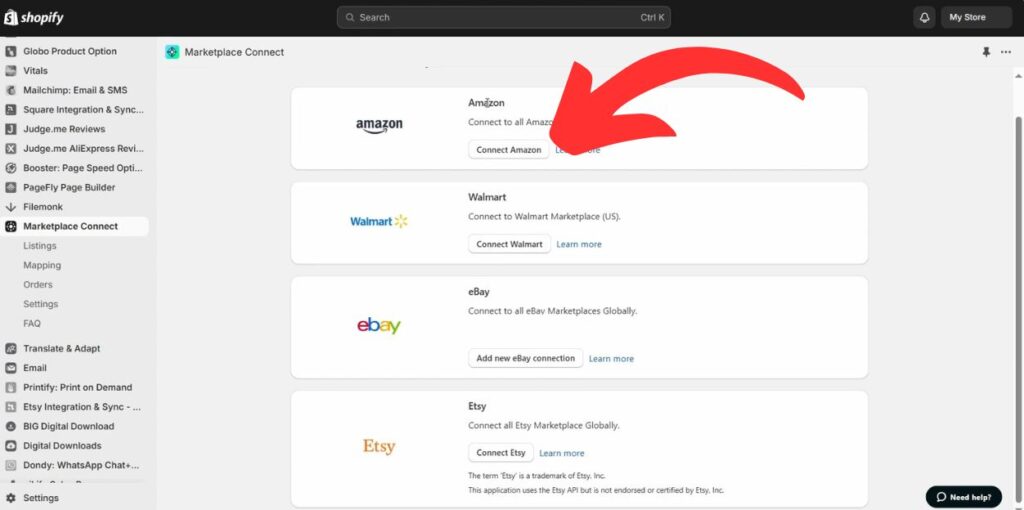
Once the app is installed:
- Open Shopify Marketplace Connect from your Apps menu.
- Click Connect Marketplace in the top right corner.
- Select Amazon from the list of available platforms.
- Choose your marketplace (Amazon.com, Amazon.ca, Amazon.co.uk, etc)
- Sign in with your Amazon Seller Central credentials.
After signing in, your Amazon account will be securely linked to your Shopify store.
Step 3: Link Your Product Listings

Once your accounts are connected, the next step is to sync your existing product listings between Shopify and Amazon. From the app’s overview page, you’ll want to click on Link Listings to get started.
The app will automatically sort your products into three categories. Ready to List includes items with an exact SKU or GTIN match between your Shopify and Amazon accounts. Close Match covers listings that are similar but require a manual review to confirm they’re the same product. Lastly, No Match includes products that don’t currently have a corresponding listing on the other platform.
It’s a good idea to carefully review anything marked as a Close Match to avoid linking the wrong items. Once you’ve confirmed your matches, click Link Listings, and the app will begin syncing your data. You can track the status of each item in the Listings tab, where you’ll see whether they’ve been successfully linked (active) or are still pending (inactive).
Step 4: Create Amazon Listings from Shopify (Optional)
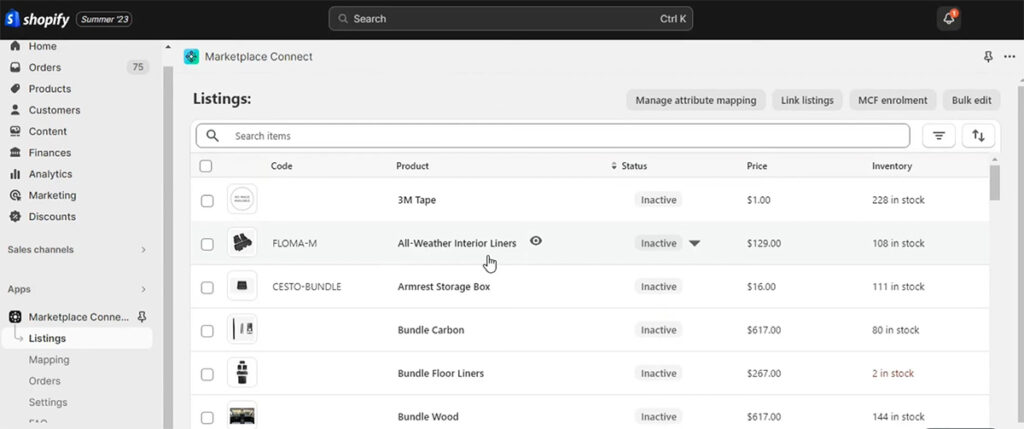
At this point, your Shopify and Amazon accounts are fully linked and can be monitored within the Marketplace Connect app on your dashboard. However, if you’re selling products on Shopify that don’t yet exist on Amazon, Marketplace Connect allows you to create new Amazon listings directly within Shopify.
Here’s how:
- Go to the Listings tab in the app.
- Click on the product you’d like to list on Amazon.
- Fill out the required Amazon listing fields—title, images, descriptions, and category settings.
Keep in mind, Amazon has its own strict product image and listing requirements, which may differ from your Shopify store’s content. This is an excellent time to optimize your images and copy specifically for Amazon. For example, if you’re Shopify store is using generic product images directly from your supplier, these images will not work for Amazon.
For a full guide on Amazon’s image requirements and tips to improve your product images, check out our detailed guide: Amazon Photography Requirements: 8 Steps to Stunning Product Images
How to Use Amazon’s Multichannel Fulfillment with Shopify
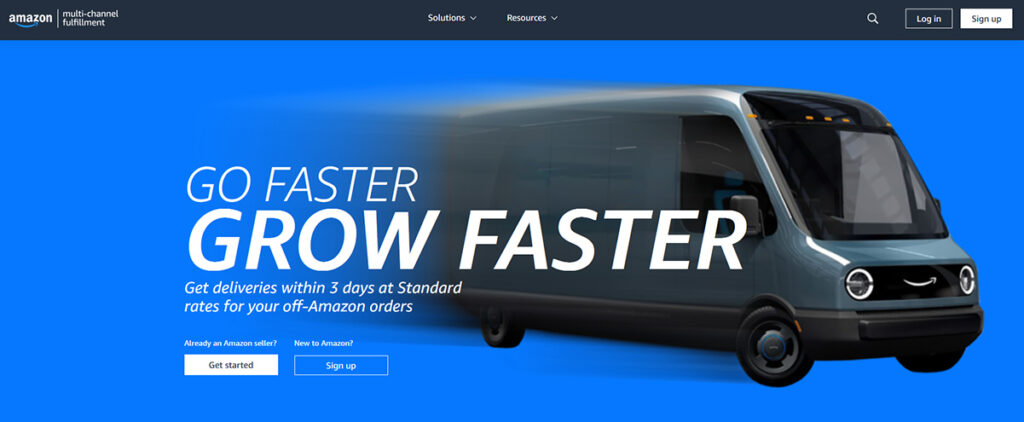
One of the advantages of linking Amazon to Shopify is the ability to leverage Amazon’s Multichannel Fulfillment (MCF) program. If you already store inventory in Amazon’s warehouses for FBA, MCF lets you fulfill orders from your Shopify store using Amazon’s shipping infrastructure, without directing customers to Amazon itself.
What is Amazon MCF, and how does it work?
Amazon Multichannel Fulfillment (MCF) is a logistics service that allows you to fulfill orders from sales channels like Shopify, Etsy, and TikTok using inventory stored in Amazon’s fulfillment centers. Once enabled, Amazon handles everything from picking and packing to shipping and delivery.
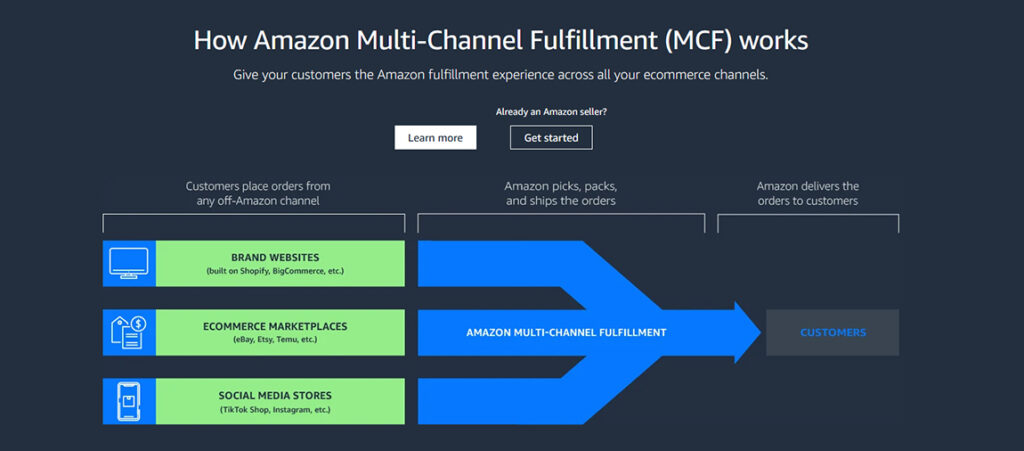
Here’s how it works:
- You send inventory to Amazon’s fulfillment centers. Amazon distributes your stock across its nationwide network.
- A customer places an order through your Shopify store.
- Amazon receives the order and fulfills it on your behalf.
- The order is delivered directly to your customer in unbranded packaging. (No Amazon logos are on the box)
Amazon offers expedited (2-day) and standard (3-day) delivery, even on weekends. With a 97% on-time delivery rate and 99.8% of packages arriving undamaged, MCF is one of the most reliable fulfillment options available for multichannel ecommerce sellers.
You’ll be charged a monthly storage fee and a per-order pick and pack fee. These rates are competitive for the speed and consistency provided, and may be especially useful for sellers scaling up or managing high order volumes.
How to Set Up Amazon MCF in Shopify
To connect your Shopify store with Amazon’s Multi-Channel Fulfillment (MCF), you’ll need to install the official Amazon MCF: US Fulfillment app from the Shopify App Store. Built by Amazon, this app lets you tap into the same fulfillment network that powers FBA, without requiring the customer to order through Amazon.
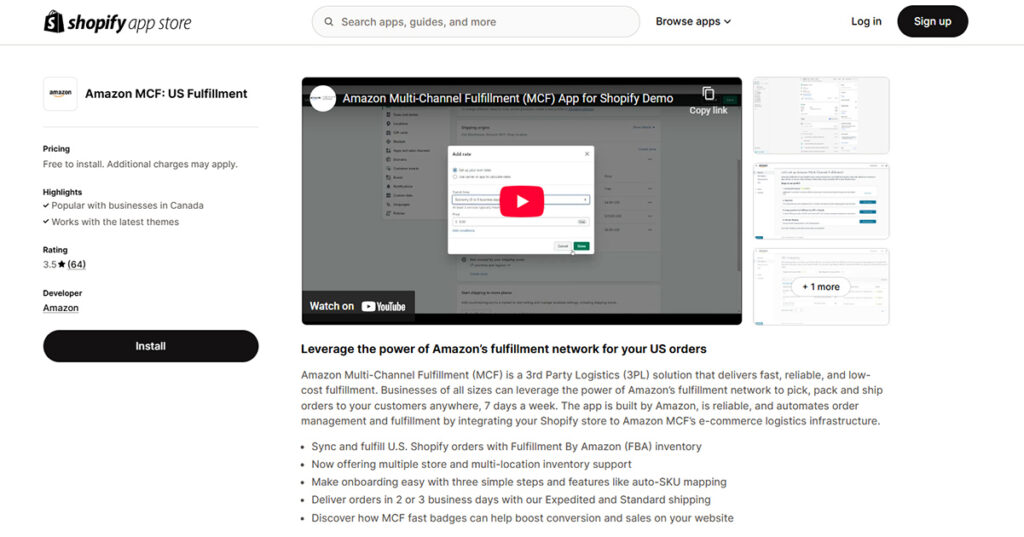
Once the app is installed, you’ll log in with your Amazon Seller Central credentials. If you don’t plan to sell on Amazon, you can still use MCF by creating a fulfillment-only account. From there, you’ll need to make sure your products are available in Amazon’s fulfillment centers. If you’re not already using FBA, this means preparing and shipping your inventory to Amazon’s warehouses before you can start fulfilling Shopify orders through MCF. Once your stock is received, Amazon will treat it as a shared inventory pool for both FBA (if applicable) and MCF.
To make sure everything syncs smoothly, it helps to have matching SKUs across Shopify and Amazon. The app can auto-map products with identical SKUs, or you can manually link items that differ. You’ll also need to assign Amazon Fulfillment as the inventory location for each product in your Shopify admin, either one by one or in bulk using Shopify’s editor.
Shipping is fully customizable. In your Shopify settings, you’ll create a shipping profile and map those options to Amazon’s delivery speeds, like Standard, Expedited, or Priority. Customers will only see the shipping rates you set, but Amazon will organize everything behind the scenes.
With everything in place, MCF will automatically fulfill your Shopify orders using your existing FBA stock—no manual routing, no warehouse headaches.
FAQs About Linking Shopify to Amazon
Can you sell on both Shopify and Amazon?
Yes, you can sell on both Shopify and Amazon at the same time. Many sellers use Shopify to build their brand and Amazon to access its massive customer base. Linking Amazon to Shopify allows you to manage inventory, track orders, and synchronize listings across both platforms, streamlining your multichannel business.
Do I need to use Amazon FBA to link with Shopify?
No, you don’t need Amazon FBA to link Shopify with Amazon. If you want Amazon to fulfill Shopify orders, you’ll use Amazon Multichannel Fulfillment (MCF) instead. MCF handles orders from your Shopify store, offers different shipping speeds, and uses unbranded packaging, but it has higher fees than FBA, which is exclusive to Amazon sellers.
Can I unlink Shopify from Amazon later?
Yes, you can unlink Shopify from Amazon at any time. To do this, simply remove the integration from your Shopify admin panel and disconnect your Amazon Seller Central account. Once disconnected, your listings, inventory sync, and order routing between platforms will stop, but your stores will continue operating independently.
Can Amazon fulfill Shopify orders?
Yes, Amazon can fulfill Shopify orders through its Multichannel Fulfillment (MCF) service. When you enable MCF and link it to your Shopify store, Amazon will ship your Shopify orders using inventory stored in its fulfillment centers. Orders are delivered in unbranded packaging, and you can choose between expedited (2-day) or standard (3-day) shipping options.
Conclusion: Should You Link Shopify to Amazon?
If you’re looking to expand your reach, improve fulfillment, and build a stronger brand presence across multiple channels, linking Shopify to Amazon is a practical next step. It doesn’t just give you access to millions of Amazon customers—it also allows you to streamline operations and offer faster shipping through services like Amazon’s Multichannel Fulfillment.
That said, success comes down to setup and strategy. When done thoughtfully, this connection can help you grow both platforms side by side, without doubling your workload. Whether you’re just getting started or ready to scale, the tools and steps in this guide are designed to help you move forward with confidence.
Recommended Articles:
- How to Create an Amazon Seller Account (Step-by-Step Guide for 2025)
- How to Start an Amazon FBA Business in 7 Simple Steps (Beginner’s Guide)
- How Much Are Amazon Seller Fees? A Complete Breakdown
Levi Adler is an experienced Amazon seller, e-commerce specialist, and the founder of Levi’s Toolbox. With over a decade in the trenches selling on Amazon and managing his own Shopify stores, Levi writes from his own experience. Sharing what worked, what flopped, and the strategies he wishes he’d known sooner. When he’s optimizing listings or managing ad campaigns, you’ll find Levi hitting mountain bike trails or hanging out with his two huskies, Emma and Scout.
